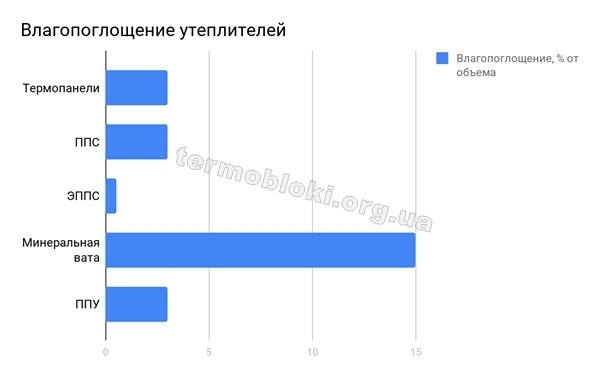A high-quality insulation must be resistant to moisture, because otherwise it will quickly lose its properties and will not be able to maintain a comfortable temperature in the house. In this regard, thermal panels are superior to other types of materials, and that’s why.
In 24 hours, the foam absorbs only 0.1% of moisture from its own volume, and then absorption ceases: this means that even in wet conditions the sheet will remain dry. Moreover, the material has at least low vapor permeability of 0.05 Mg / (m*h*Pa), and is also resistant to the formation of fungi and mold. It is not for nothing that polystyrene is most often used for warming walls and facades.
However, if polystyrene foam is left in direct sunlight for a long time, it begins to break down, which means that the path of moisture and fungus opens between the granules. Therefore, foam insulation is always protected by finishing: plastering and painting or gluing tiles. In this case, he has served for decades.
Naturally, if we compare the two types of finish in terms of moisture resistance and resistance to natural phenomena, clinker tiles made of refractory clay are many times more reliable than “fur coats” and “wet facades”. It does not crack as the first type of cladding, and will last much longer.
Total: buying a ready-made thermal panel, you get a moisture-proof insulation, which is additionally protected by a clinker.
If we figured out the foam for plaster, then why is a thermopanel more profitable in moisture resistance than extruded polystyrene foam, mineral wool and polyurethane foam? Let’s go through each heater.

Extruded Styrofoam – even more moisture-resistant material than regular polystyrene foam: in a month it absorbs no more than 0.5% moisture from its own volume. Its structure is different from expanded polystyrene: it is more dense, and therefore the extruded PPP is ideal for warming the foundation and underfloor heating.
But Extruded Styrofoam is not suitable for warming facades, since it practically does not let air through: depending on the thickness of the sheet, its vapor permeability coefficient is only 0.007-0.012 Mg / (m*h*Pa). This means that the panel not only does not absorb moisture from the outside, but also does not let out fumes from the walls. Such “conservation” is the increased humidity in the room, condensation draining from the windows, raw wallpaper and fungus.
Such insulation is only possible with proper ventilation design.
In theory, slag wool, glass wool and basalt wool have a high vapor permeability of 0.3-0.7 Mg / (m * h * Pa) and low water absorption of 1-2% per day. But in practice, this is possible only under ideal conditions: when a vapor barrier is placed under the cotton wool, and on it is a protective membrane or plastic film, and there are no gaps, crevices, and peeling pieces of cotton wool.
Otherwise, mineral wool perfectly absorbs (from 15% or more) and poorly evaporates moisture, the fibers sag and begin to pass heat.
Therefore, prior to installation, the sheets are stored in a package under conditions that exclude their moisture.
Basalt cotton wool is the most dense, and therefore better resists moisture than glass wool, but it should also be used with vapor barrier.
The properties of PUFs depend on its type. Open-cell polyurethane foam has excellent vapor permeability of 0.8-0.1 Mg / (m * h * Pa), but at the same time it has a high moisture absorption of 15% and a service life of 5-7 years. Experts compare it with mineral wool and advise using it only with a moisture and vapor barrier.
Closed-cell polyurethane foam is moisture-resistant: like foam, it absorbs up to 3% moisture, and has low vapor permeability at a level of up to 0.5 Mg / (m*h*Pa). At the same time, it is deprived of cuts through which moisture could escape, it costs several times more, and its spraying requires warm, dry weather to avoid further cracking. The material also decomposes under the influence of the sun, emits phenol, but it is problematic to carry out a protective finish because of the uneven surface.
Thus, clinker thermal panels made of expanded polystyrene are the most cost-effective and optimal insulation moisture resistance for facades.